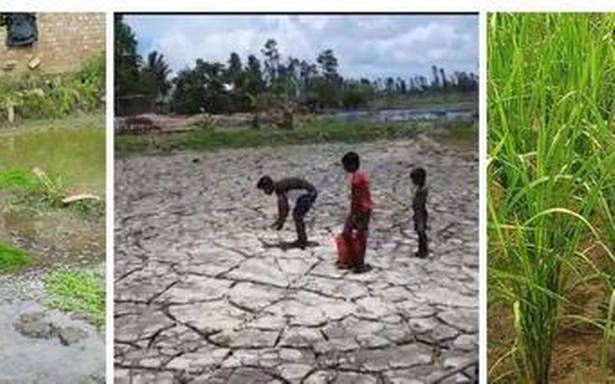‘It will provide long-term sustainable ecological and economic empowerment to farmers’
In the last week of May 2021, when large areas of the Sunderbans were inundated by saline water under the impact of Cyclone Yaas, farmers across the region had given up hope for fresh crop this season. Based on earlier experiences of cyclones, many farmers like Biswajit Jana thought that they might not cultivate for the next few years.
However, a unique project of reclamation of soil salinity in the Sonagaon village in Gosaba block has given hope to many farmers of the region.
Restoration project
A group of conservationists and scientists has come together in this restoration project cultivating paddy in a 10-bigha plot months after the cyclone has ravaged the landscape. “Usually, the focus in the Sundarbans after a cyclone is on short term relief but what we tried to do is to provide a long-term sustainable ecological and economic empowerment to the people,” Diya Banerjee of Uttarayan Wildlife told The Hindu.
Ms. Banerjee said initially those behind the desalination project were not very sure about the success but the yield of paddy has surprised everyone. The novel initiative is supported by the Uttarayan Wildlife and the Nature Mates provided logistical support to the initiative. Both the organisations have been working in the Sundarbans for quite some time.
Pradip Sen, retired additional director research, Department of Agriculture, said the only technique known for desalination is freshwater irrigation which is very difficult in the Sunderbans.
“The salinity of the plot after the cyclone was 17.4 dS/m [salinity is measured using deciSiemens per metre -dS/m] but after the desalination exercise it was down to 2.04 dS/m. We also cultivated a variety of paddy which is relatively less resistant to soil salinity and the output has been very encouraging,” Dr. Sen, who is associated with the Uttarayan Wildlife and provided scientific support to the desalination exercise, said.
The scientists said a particular process of desalination was followed which allowed all water to drain out naturally.
Combination of organic manure, paddy husk
“In the soil which was muddy, we mixed a combination of organic manure and paddy husk and allowed it to remain so for two to three weeks before the paddy was sown,” he said.
Those behind the initiative are of the opinion that such restoration of soil salinity and reclaimation for agriculture should be carried on a much bigger scale in the Sundarbans. This will not only provide food security but also become a tool in empowering people in the ecologically fragile ecosystem. After the cyclones, the Government has been giving farmers salt tolerant varieties of paddy to be cultivated but no such model for restoring and reclaiming soil salinity had been tried in the region.
Source: Read Full Article

